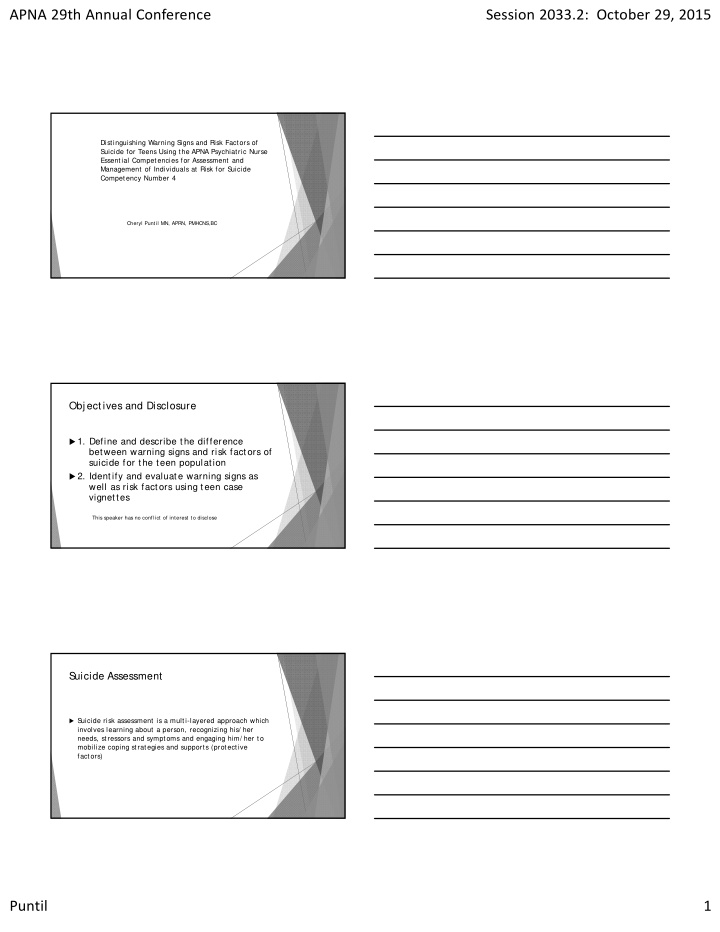



APNA 29th Annual Conference Session 2033.2: October 29, 2015 Distinguishing Warning S igns and Risk Factors of S uicide for Teens Using the APNA Psychiatric Nurse Essential Competencies for Assessment and Management of Individuals at Risk for S uicide Competency Number 4 Cheryl Puntil MN, APRN, PMHCNS ,BC Obj ectives and Disclosure 1. Define and describe the difference between warning signs and risk factors of suicide for the teen population 2. Identify and evaluate warning signs as well as risk factors using teen case vignettes This speaker has no conflict of interest to disclose S uicide Assessment S uicide risk assessment is a multi-layered approach which involves learning about a person, recognizing his/ her needs, stressors and symptoms and engaging him/ her to mobilize coping strategies and supports (protective factors) Puntil 1
APNA 29th Annual Conference Session 2033.2: October 29, 2015 Thoughts to consider about teens S uicide is the third leading cause of death among persons aged 10-14, the second among persons aged 15-34 years, … .(CDC,2013) Often related to depression and anxiety and feeling trapped with no way out. The difference between boys and girls Consider the developmental level Bullying and the Internet Contagious Factors- exposure to friends or family members suicide LGBT youth Definitions Risk Factors- refer to personal or environmental characteristics that are associated with suicide. The environment includes social and cultural environment as well as the physical environment. (S AMHS A, 2012) Warning Signs- are factors that may set into motion the process of suicide in the short term ( ie: minutes and days) Warning signs present tangible evidence to the clinician that a person is at a heightened risk of suicide in the short term. Warning signs of teen suicide Disinterest in favorite extracurricular activities Problems at work and losing interest in a j ob Substance abuse, including alcohol and drug (illegal and legal drugs) use Behavioral problems Withdrawing from family and friends Sleep changes Changes in eating habits Begins to neglect hygiene and other matters of personal appearance Emotional distress brings on physical complaints (aches, fatigues, migraines) Hard time concentrating and paying attention Declining grades in school Loss of interest in schoolwork Risk taking behaviors Complains more frequently of boredom Does not respond as before to praise Puntil 2
APNA 29th Annual Conference Session 2033.2: October 29, 2015 Teen S uicide Warning S igns: indications of a suicide plan There are some things that teens might do that could indicate that they are contemplating, or even planning, suicide. It is important that you make yourself aware of these actions, and use them as starting points to draw your teenager out and perhaps express what is bothering him or her. Here are some of the indications of a suicide plan: • Actually says, “I’m thinking of committing suicide” or “I want to kill myself” or “I wish I could die.” There are also verbal hints that could indicate suicidal thoughts or plans. These include such • phrases as: “I want you to know something, in case something happens to me” or “I won’t trouble you anymore.” • Teenager begins giving away favorite belongings, or promising them to friends and family members. • Throws away important possessions. • Shows signs of extreme cheerfulness following periods of depression. Creates suicide notes. • Expresses bizarre or unsettling thoughts on occasion. • Protective Factors can buffer the effects of risk factors Family and S chool Connectedness Academic achievement S elf esteem Friends are often the first to know Coping skills, including conflict resolution and non violent handling of disputes S piritual faith or regular church attendance Restricted access to firearms, over the counter medications and prescriptions Restricted access to alcohol Test your knowledge and identify the risk factors , warning signs and imminent risk. References APNA Psychiatric-Mental Health Nurse Essential Competencies for Assessment and Management of Individuals at Risk for S uicide retrieved 10-6-2015 from: http:/ / www.apna.org/ files/ public/ Resources/ S uicide% 20Competencies% 20f or% 20Psychiatric-Mental% 20Health% 20Nurses(1).pdf CDC S uicide Facts at a Glance retrieved 10-6-2015 from http:/ / www.cdc.gov/ violenceprevent ion/ pdf/ suicide-datasheet-a.pdf Centers for Disease Control and Prevention (CDC). Web-based Inj ury S tatistics Query and Reporting S ystem (WIS QARS) [Online]. (2013, 2011) National Center for Inj ury Prevention and Control, CDC (producer). Available from www.cdc.gov/ inj ury/ wisqars/ index.html. National Institute of Mental Health S uicide S tatistics retrieved 10-6-2015 from: http:/ / www.nimh.nih.gov/ health/ topics/ suicide-prevent ion/ index.shtml#part _149722 S ubstance Abuse and Mental Health S ervices Administration. Preventing S uicide: A Toolkit for High S chools. HHS Publication No. S MA-12-4669. Rockville, MD: Center for Mental Health S ervices, S ubstance Abuse and Ment al Health S ervices Administration, 2012. Teen Warning S igns and Teen Indications of a S uicide Plan retrieved 10-6-2015 from: http:/ / www.teensuicide.us/ articles2.html- Puntil 3
Recommend
More recommend